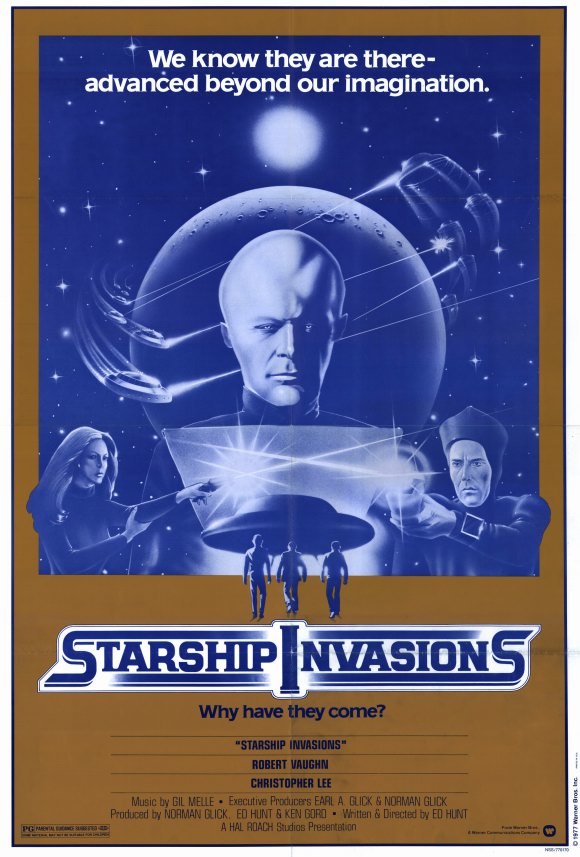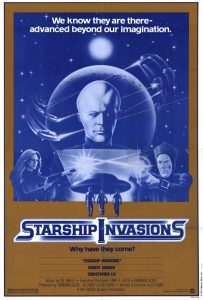Made in the late 1970s, Starship Invasions was a fairly blatant attempt to capitalize on the resurgence of interest in sci-fi spearheaded by Star Wars and Close Encounters of the Third Kind. This obviously low-budget attempt may have unconvincing sets and an overly complicated plot, but don’t count it out yet. Starship Invasions still has a few tricks up it’s tinfoil-wrapped sleeve, not the least of which is two big name actors– Christopher Lee and Napoleon Solo himself, Mr. Robert Vaughn.
Although Starship Invasions’ director Ed Hunt is an American, his resume uncannily reads like many of our native schlock filmmakers. Living in the U.S. but filming almost exclusively in the Great White North, Hunt started his career with a couple of softcore features, Diary of a Sinner (1974) and Pleasure Palace (1973), an obscurity notable for starring current CBC personality Vicki Gabereau. His next film, the virtually unseen UFO story Point of No Return steered Hunt into the more commercial territory of horror and science fiction. It was here that Hunt would finish out his career with 1988’s fun amalgam of genre clichs, The Brain.
Made just after Point of No Return, Starship Invasions has so far proved to be Hunt’s most sought-after film, perhaps because of the sheer ambitiousness of it all. Never again would Hunt work with such talented performers, and the budgets of his other films rarely approached even half of what was spent on this epic. It also helps that Hunt’s films are generally enjoyable trash, and despite the fact that Starship Invasions has it’s share of problems, it’s definitely a film that would benefit from a DVD release.
Perched atop his tractor, a chubby farmer named Rudy calmly watches a UFO land in his field, and remains unfazed as two men in black body leotards emerge and hustle him aboard. Rudy languidly submits to a couple of probes, but starts to get interested in his perdicament when a naked women suddenly appears to seduce him. How’s that for grabbing your audience in the first scene? The next day Rudy tells his tale to a smirking police detective, and is laughed off as a moonshine guzzlin’ hick. Spurned, Rudy invites true believer and UFO enthusiast Professor Allan Duncan (Vaughn) to visit the landing site. Duncan examines the scorched field, and tells Rudy that aliens have been visiting Earth for years. When they finally reveal themselves, nobody will laugh at him again!
Meanwhile, back aboard the UFO, Captain Rameses (Lee) and his crew from planet Alpha are back to their old kidnapping ways. Rudy the dirt farmer proved to be such an ideal male specimen that they decide to probe an Earth female as well. Rameses reveals that since their sun is about to supernova, the Alphanians are looking for a new planet to colonize. Once they find a suitable place, they will kill all the inhabitants, and signal their other ships currently hiding behind the moon. But there’s a problem: unbeknownst to the puny earthlings, their home is protected by a “galactic treaty” established by an intergalactic council called “The League of Races.”
If you were the League of Races, where would you hide your Earth headquarters? If you said “Under the ocean in a giant pyramid,” give yourself five space points. Landing at the base with anything but honest intentions, Ramses is taken to the head of the League by an android named Durbal. On closer inspection, Durbal seems to be a man in a silver snow suit with a coffee urn strapped to his head. While Ramses distracts the council, the other Alphanians sabotage a League UFO, causing it to be spotted and destroyed by the army on a routine surveillance flight. In the confusion this causes, Rameses and his crew put miniature laser guns on their fingers and take over the pyramid, seriously injuring our beloved Durbal. Moving into the next phase of his plan, Rameses contacts another Alphanian ship which orbits the Earth with a “suicide ray.” Turning this ray on our cities, ordinary citizens suddenly go crazy, and after a brief killing spree, take their own life.
But what Rameses hadn’t counted on is that one League UFOs manages to slip away. Two dedicated Leauge of Races representatives swing by and pick up Professor Allan Duncan and his best buddy Malcom, a computer expert (and newly converted UFO skeptic). With Malcom’s help, they are able to modify the UFO’s communications systems to send an S.O.S. to League ships on nearby planets. Audience anticipation for the impending spectacular laser battle may be high at this point, but Hunt decides to make us listen to more boring UFO conspiracy theories instead. Duncan begins asking lots of questions, and the League talk about their technologies and culture, explaining how aliens built the ancient pyramids, a point already belaboured with all of the persistent Egyptian references (Captain Rameses?!).
Finally, the opposing fleets meet in the dark void of space to start a war in the stars. With special effects uncannily recalling the Atari 2600 classic Asteroids, things are getting desperate for the League of Races– The Alphanians are using the computers at the League HQ to give them “superior calculations”! And to make matters worse, Duncan’s wife has picked up a kitchen knife and begins slashing her wrists! Will Professor Duncan and his good aliens be too late to stop the suicide ray?
While not comparable to a big-budget film like Close Encounters, this Canadian movie actually has a few reasonably well-done effects, although the epic space battle which might make you wince a bit. Still, Hunt slashes away at his overhead in the time-tested fashioned, utilizing such tricks as poorly matched ” military in action” stock scenes, consistently repeated footage of Rameses manning his UFO controls, and most obviously, overdubbed dialogue. Since all of the alien races communicate telepathically in Starship Invasions, many scenes were apparently filmed without sound which was recorded and inserted later.
Although science-fiction was all the rage in Hollywood when Starship Invasions was released in 1977, this genre was really nowhere to be found on the map of Canadian film. At the time, the majority of the loans offered by the eight-year-old Canadian Film Development Corporation had mostly been poured into low-budget horror and crime films. Canada’s one sci-fi attempt thus far was not a film but a TV series, The Starlost, which debut in 1973. The show’s producer-director team of Norman Klenman and William Davidson were no strangers to Canuxploitation films themselves, having already made a handful of movies including The Ivy League Killers, a rare 1959 juvenile delinquincy picture. The Starlost, which featured Robin Ward and British import Kier Dullea, debuted as the biggest and most expensive series ever mounted on Canadian TV. After the initial excitement passed, the show lasted only 16 episodes, due to poor ratings and clashes with original writer/collaborator Harlan Ellison. Since then it has become a cult favourite due in no small part to the laughably outdated chroma-key special effects. Hunt was undoubtedly influenced by the potential of The Starlost, and was the first to take Canadian sci-fi to the next level with Point of No Return and subsequently to popularize it with Starship Invasions. These were the first real Canadian science-fiction films, not only paving the way for dreck like Starlight and Laserhawk, but helping to secure science fiction as one of the most prolific genres for straight-to-video Canuxploitation films in the 1990s.
Many Canadian tax shelter films pretend to be set in the United States, but Starship Invasions seems confused about where the action is unfolding. No attempts were made to disguise Toronto landmarks including the CN Tower, and at one point a character holds up the front page of The Toronto Star newspaper. However, other scenes point to a U.S. setting, including a war room conference in “Chicago.”
Although it is relatively painless to watch, Starship Invasions takes itself a little to seriously to really be successful. It’s obvious that Hunt is fascinated with UFOlogy, having made no less than three films which delve into the subject. Unfortunately, his attempt to marry the more “scientific” UFO lore found in dusty library books to “space opera” concepts such as underwater pyramids and Durbal, the ill-conceived robot, was doomed to fail from the beginning. Still, Starship Invasions remains a matinee favourite of many, and represents an important landmark in the development of Canadian genre film.
Foundational Cinema
Copyright © 2025 The B Movie Nation


